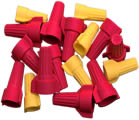How an Electrical Outlet Works
Modern U.S. electrical outlets, also called receptacles, have three holes; two parallel slots of unequal size, and a half round for equipment ground. Older outlets may not have a ground or polarized slots.
Caution: Please read our safety information before attempting any testing or repairs. References to existing wiring assume that it is properly wired, which may not be the case in your home.
What are polarized electrical outlets?
The different sized slots were developed to allow outlets to be polarized as a safety enhancement. The larger slot connects the common wire in the outlet to the common wire in a device. The smaller slot connects the "hot" wires. By forcing the smaller blade of the plug to always connect the hot wires, the outlet is polarized. Devices, such as a table lamp, are designed to minimize the risk of electric shock by keeping the hot wire as short as possible by wiring directly to the switch. The rest of the internal wiring connects to the neutral wire. While this system does not eliminate the possibility of electrocution, fire and electrical faults, it reduces the risk by limiting the path of live current.
What does the ground do?
Another improvement in safety came with the addition of a ground wire to the outlet. This serves as an alternative return path for electricity and is referred to as the equipment ground. Ordinarily current flows from the hot wire and returns via the common wire to ground. However, if the hot wire comes in contact with a metal part of a device, the outer cabinet housing of a washing machine for instance, current could flow through you to ground. The ground wire in a device connects to the housing and provides a return path. The current could still travel through you, but the ground wire probably has lower resistance and so chooses that path over through you.
page 1 of 2





